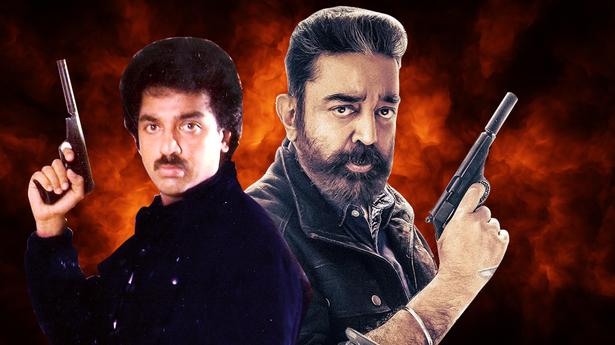
When Kamal Haasan (almost) made a Bond film
The Hindu
Ahead of the new Vikram directed by Lokesh Kanagaraj, we take a trip down memory lane to look at the original 1986 film and what it meant to people who grew up in the 1990s
Movies you discover on your own during childhood tend to have a lasting impact. You get emotionally attached to those movies which later on act as gateways to nostalgia, reflecting the phases of life and the innocence that comes with it. As you grow older, your taste and sensibilities change but you still have a soft spot for the movies you saw as a child. You still feel for such films. For people who grew up in the 1990s, the Kamal Haasan-starrer Vikram was one such discovery.
Watching Kamal in silhouette as a quasi-Bond in the title track of Vikram sealed the deal for most of us. Our fascination also comes from the fact that it was the time when video games consoles — the ones that came in cassettes — were penetrating our lives. Vikram felt like one of those cool games you never wanted to end, especially the film’s Salamia portion. Even Ilaiyaraaja’s background music had that video game sound. What is still etched in memory are the multiple explosions that happen in the film (which felt real) and the fancy props including the missile named Agni Putra.
A lot of people still haven’t seen Vikram. For their benefit, the film is about an intelligent agent Arun Kumar Vikram (played by Kamal Haasan) who is forced to rejoin the agency as a result of his personal loss. Vikram is assigned a task to retrieve a missing nuclear missile, which is in the hands of Sugirtharaj (Sathyaraj) who seeks asylum in a fictional kingdom called Salamia.
As the story goes, Kamal decided to adapt veteran Tamil writer Sujatha’s Vikram, which was published as a series in a popular Tamil magazine. They worked on the screenplay, trying to marry the coolness of a Bond movie and the sensibilities of Tamil cinema.
Directed by Rajashekar, the film was a commercial success. But, over the years, Kamal has been a caustic critic and has often been dismissive of Vikram, saying that it was “diluted for the Kodambakkam audience”. He said something to the effect of this: “Imagine Bond being assigned a task and before he gets on the mission, he has to stop by a temple and break coconut for Lord Ganesh. That’s what happened to Vikram (sic).” You get why.
Revisiting Vikram today, without the weight of childhood and nostalgia, did not make sense. Clearly it has stood the test of time, unlike some of Kamal’s other works. The reason could be the screenplay written by Sujatha and Kamal. You see the vision that they had but you also only see the ideas. The film today gives you the feel of being overstuffed with concepts for two kinds of films: an uber-cool Bond movie in the first half and a madcap action-adventure like Indiana Jones or Mad Max series in the second half. Vikram ended up being neither here nor there. Perhaps a more competent filmmaker may have managed to bridge this screenplay gap. And Rajashekar was never Kamal’s first choice.
Even very recently, when Kamal was asked about Rajashekar’s legacy at the Vikram press meet, he gave a measured reply by calling him a “great commercial filmmaker”. “It [Vikram] was Mani Ratnam’s cup of tea,” wrote Kamal in an article in The Hindu, celebrating 25 years of Nayakan. Perhaps Kamal was right.











